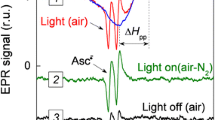Abstract
A reconstituted spinach chloroplast system containing thylakoids, stroma and 0.1 mM NADPH supported O2 evolution in the presence of oxidised glutathione (GSSG). The properties of the reaction were consistent with light-coupled GSSG-reductase activity involving H2O as eventual electron donor. The reconstituted system also supported dehydroascorbate-dependent O2 evolution in the presence of 0.6 mM reduced glutathione (GSH) and 0.1 mM NADPH with the concomitant production of ascorbate. The GSSG could replace GSH in which case the production of GSH preceded the accumulation of ascorbate. The data are consistent with the light-dependent reduction of dehydroascorbate using H2O as eventual electron donor via the sequence H2O→NADP→GSSG→dehydroascorbate. Approximately 30% of the GSH-dehydrogenase activity of spinach leaf protoplasts is localised in chloroplasts: this could not be attributed to contamination of chloroplasts by activity from the extrachloroplast compartment. Washed intact chloroplasts supported the uptake of ascorbate but the uptake mechanism had a very low affinity for ascorbate (Km approximately 20 mM). The rate of uptake of ascorbate was less than the rate of light-dependent reduction of dehydroascorbate and too slow to account for the rate of H2O2 reduction by washed intact chloroplasts.
Similar content being viewed by others
Abbreviations
- Chl:
-
chlorophyll
- GSH:
-
reduced glutathione
- GSSG:
-
oxidised glutathione. In the text, glutathione refers collectively to GSH plus GSSG
References
Allen, J.F. (1977a) Oxygen — A physiological electron acceptor in photosynthesis. Curr. Adv. Plant Sci. 29, 459–469
Allen, J.F. (1977b) Effects of washing and osmotic shock on catalase activity of intact chloroplast preparations. FEBS Lett. 84, 221–224
Bradbeer, J.W. (1969) The activities of the photosynthetic carbon cycle enzymes of greening bean leaves. New Phytol. 68, 233–245
Edwards, G.E., Robinson, S.P., Tyler, N.J.C., Walker, D.A. (1978) Photosynthesis by isolated protoplasts, protoplast extracts and chloroplasts of wheat. Influence of orthophosphate, pyrophosphate and adenylates. Plant Physiol. 62, 313–319
Foyer, C.H., Halliwell, B. (1976) The presence of glutathione and glutathione reductase in chloroplasts: a proposed role in ascorbic acid metabolism. Planta 133, 21–25
Foyer, C.H., Halliwell, B. (1977) Purification and properties of dehydroascorbate reductase from spinach leaves. Phytochemistry 16, 1347–1350
Foyer, C.H., Rowell, J., Walker, D.A. (1983) Measurement of the ascorbate content of spinach leaf protoplasts and chloroplasts during illumination. Planta 157, 239–244
Fridovich, I. (1975) Superoxide dismutases. Annu. Rev. Biochem. 44, 147–159
Halliwell, B. (1974) Superoxide dismutase, catalase and glutathione peroxidase: solutions to the problems of living with O2. New Phytol. 73, 1075–1086
Halliwell, B., Foyer, C.H. (1978) Properties and physiological function of a glutathione reductase purified from spinach leaves by affinity chromatography. Planta 139, 9–17
Heldt, H.W. (1980) Measurement of metabolite movement across the envelope and of the pH in the stroma and the thylakoid space in intact chloroplasts. Methods Enzymol. 69, 604–613
Jablonski, P.P. (1981) Reduction of hydrogen peroxide and selenite in illuminated pea chloroplasts. Ph.D. thesis, La Trobe University, Melbourne, Australia
Jablonski, P.P., Anderson, J.W. (1978) Light-dependent reduction of oxidized glutathione by ruptured chloroplasts. Plant Physiol. 61, 221–225
Jablonski, P.P., Anderson, J.W. (1981) Light-dependent reduction of dehydroascorbate by ruptured pea chloroplasts. Plant Physiol 67, 1239–1244
Jablonski, P.P., Anderson, J.W. (1982) Light-dependent reduction of hydrogen peroxide by ruptured pea chloroplasts. Plant Physiol 69, 1407–1413
Kaiser, M.W. (1976) The effect of hydrogen peroxide on CO2 fixation of isolated chloroplasts. Biochim. Biophys. Acta 440, 476–482
Law, M.Y., Halliwell, B. (1983) Glutathione and ascorbic acid in spinach (Spinacia oleracea) chloroplasts. The effect of hydrogen peroxide and of paraquat. Biochem. J. 210 (in press)
Lilley, R. McC., Fitzgerald, M.P., Rienits, K.G., Walker, D.A. (1975) Criteria of intactness and photosynthetic activity of spinach chloroplast preparations. New Phytol. 75, 1–10
Lilley, R. McC., Walker, D.A. (1979) Studies with the reconstituted chloroplast system. In: Encyclopedia of plant physiology, N.S., vol. 6: Photosynthesis II. Photosynthetic carbon metabolism and related processes, pp. 41–52, Gibbs, M., Latzko, E., eds. Springer, Berlin Heidelberg New York
Mapson, L.W., Isherwood, F.A. (1963) Glutathione reductase from germinated peas. Biochem. J. 86, 173–191
Mehler, A.H. (1951) Studies on reactions of illuminated chloroplasts I. Mechanism of the reduction of oxygen and other Hill reagents. Arch. Biochim. Biophys. 33, 65–67
Nakano, Y., Asada, K. (1980) Spinach chloroplasts scavenge hydrogen peroxide on illumination. Plant Cell Physiol 21, 1295–1307
Nakano, Y., Asada, K. (1981) Hydrogen peroxide is scavenged by ascorbate-specific peroxidase in spinach chloroplasts Plant Cell Physiol. 22, 867–880
Owens, C.W.I., Belcher, R.V. (1965) A colorimetric micro method for the determination of glutathione. Biochem. J. 94, 705–711
Robinson, S.P., Walker, D.A. (1979) Rapid separation of the chloroplast and cytoplasmic fractions from intact leaf protoplasts. Arch. Biochem. Biophys. 196, 319–333
Schaedle, M., Bassham, J.A. (1977) Chloroplast glutathione reductase. Plant Physiol. 59, 1011–1012
Slabas, A.R., Walker, D.A. (1976) Inhibition of spinach phosphoribulokinase by DL-glyceraldehyde. Biochem. J. 153, 613–619
Smith, J., Shrift, A. (1979) Phylogenetic distribution of glutathione peroxidase. Comp. Biochem. Physiol. B 63, 39–44
Stadtman, T.C. (1979) Some selenium-dependent biochemical processes. Adv. Enzymol. 48, 1–28
Tagawa, K., Arnon, D.I. (1962) Ferredoxins as electron carriers in photosynthesis and in the biological production and consumption of hydrogen gas. Nature (London) 195, 537–543
Walker, D.A. (1980) Preparation of higher plant chloroplasts. Methods Enzymol. 69, 94–104
Wong, K.F., Davies, D.D. (1973) Regulation of phosphoenolpyruvate carboxylase of Zea mays by metabolites. Biochem. J. 131, 451–458
Author information
Authors and Affiliations
Rights and permissions
About this article
Cite this article
Anderson, J.W., Foyer, C.H. & Walker, D.A. Light-dependent reduction of dehydroascorbate and uptake of exogenous ascorbate by spinach chloroplasts. Planta 158, 442–450 (1983). https://doi.org/10.1007/BF00397738
Received:
Accepted:
Issue Date:
DOI: https://doi.org/10.1007/BF00397738




